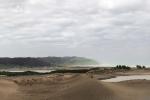NZ Steel Monitoring Environmental Effects

In 2007 NZMRM created its Sustainability Sub-committee following the creation of the NZ Green Building Council in 2005, and the development of the Green Star building rating system. At that time, we had wanted to have NZ made steel included in the Green Star system, but for various reasons this took until 2016 (and was reported on in Scope).
During the eleven years since, we have promoted the use of NZ steel in Scope and elsewhere and have used a lot of material emphasising the sustainability credentials of New Zealand Steel itself.
In the last couple of years we have decided to “recycle” some Scope technical and sustainability articles on the basis that many are still relevant and that many readers will either not have seen the originals or forgotten them.
What has been interesting is how much things have advanced in the sustainability arena (and how some haven’t!) Reading material written and published in 2008-10 I am struck by the fact that some of this could just be reissued because we have the same problems – but also how much has change positively.
One of these areas is the amount of material available from NZ (and international) sources. In 2009, NZMRM wrote most of the material or adopted it from various sources. Today, we have an excellent resource in the NZ Steel website’s Sustainability section, and rather than rewriting any of this, we now propose to use this material in bite-sized chunks and present it to Scope readers with some illustrations.
We will revisit items like use of water, transport and the manufacturing process (as well as how to use NZ made steel in the Green Star rating system) but first something new – how to monitor and assess their effects on the environment, with some emphasis on the use of water, of which NZ Steel use huge quantities. Here it is -
MONITORING ENVIRONMENTAL EFFECTS
Water management
New Zealand Steel’s Environmental Management System places great importance on its commitment to minimise any effects of taking or discharging water, as well as controlling the use of water. In order to fulfil this commitment, the company employs a rigorous monitoring programme with regular reports to the Auckland and Waikato Councils, as well as the involvement of independent environmental consultants.
A rigorous monitoring programme has been established for assessing the water quality discharged to natural waterways, as well as the health of receiving environment. This includes:
1. Daily grab sampling
2. Continuous flow-proportional composite sampling
3. Biological monitoring in the mixing zone (the area where the discharged water mixes with estuary water)
4. Continuous turbidity sampling
5. Groundwater sampling
NZ Steel’s laboratory is independently certified to undertake the analysis and Auckland Council accepts this self-monitoring regime. For verification periodically samples are duplicated, with one sample sent to an off-site laboratory to confirm the analytical techniques used by the NZS Laboratory. Telarc annually audit laboratory protocols to ensure that IANZ certification standards are maintained.
The quality of wastewater is controlled and monitored as it leaves the Steel Mills’ wastewater treatment plants and treatment ponds. So Utilities staff will adjust the water quality on the basis of the continuous readings they receive in the control room.
Daily Grab Samples
To verify discharge consent conditions are being met, each day New Zealand Steel laboratory staff take samples of the wastewater at the point the discharge enters the Waiuku Estuary. The grab sample is a 5-litre container of discharged water collected at the same time the day’s composite sample is collected. The onsite laboratory tests these samples and the results are reviewed to ensure that discharges continue to comply with resource consent conditions for a range of analytes. The results are reported to the Council each month, and the Community Environmental Committee four monthly.
Composite Samples
The composite sample is taken on a 24 hour flow-proportional basis. That means at the Northside Outfall, for every 100 tonnes of water discharged from the steel mill a sample of water is abstracted into that day’s sample container. After 24 hours, these samples are taken to the NZS laboratory for analysis. The results of all discharge samples are electronically transmitted to operations and environmental staff who compare the results with the conditions set by the resource consent. In the rare event a discharge consent condition is not met a thorough investigation is undertaken and remedial action put in place quickly. This incident report is also shared immediately with Council.
Discharge Water Quality Standards
On the Northside and Southside outfalls, the elements which are analysed in the laboratory and the frequency of sampling are listed below. These are specified in the resource consents held by New Zealand Steel.
Daily
• temperature
• pH (acidity scale)
• suspended solids
• dissolved oxygen
• a range of metals
In addition continuous turbidity (clarity) meters operate on the separate ironsand dewatering plant discharge and treatment ponds collecting surface runoff from the raw materials yards., where the only potential contaminants are clay minerals derived from the ironsand deposit.
The WNH mine also uses a continuous turbidity for its discharge to the Waikato River.
Weekly/monthly
• oils
• a range of metals
Biological Monitoring in Mixing Zone
Where the wastewater discharges into the Waiuku Estuary there is an area in which the wastewater mixes with the water of the Estuary. This is referred to as the New Zealand Steel ‘mixing zone’. Independent biological consultants sample in the mixing zone to ensure that marine life is not being adversely affected. This includes density of the Pacific Oyster (considered a key indicator species as it is a filtration feeder) and macro-invertebrates which are minute creatures living in sediments.
The water quality standards set for the wastewater discharge to the Waiuku Estuary were derived following consideration of the potential for adverse effects on marine organisms and possible accumulation of metals in sediments within the mixing zone. Monitoring of metals in sediment and shellfish provides a sensitive indicator of the degree of contamination by metals in the marine ecosystem. The monitoring results for shellfish and sediments within the mixing zone are forwarded to the Auckland Council. The Council also conducts surveys in the Waiuku Estuary and wider Manukau Harbour.
Monitoring Air Quality in the Community
New Zealand Steel has an ambient air monitoring programme in place to assess air quality at the boundary of the industrial site and in the community.
Continuous monitoring of the effect of Glenbrook’s operations is an essential part of the company’s commitment to minimise emissions. When ambient dust levels reach levels are nearing the national standard at any of the 6 ambient monitoring stations then an alert is sent to environmental and operational staff to investigate what can be done to reduce the dust leaving the site.
The air emissions discharged via stacks are also monitored regularly. Sampling equipment is inserted inside the stack and a sample is taken to measure the volume of dust emitted from the stack, or hydrogen chloride levels in the case of the pickling line, where acid is used in the process.
The regular monitoring programme includes:
• Measuring total suspended particles in the air, at six sites in the community
• Measuring particle matter and chemicals in stack emissions
The objectives of the monitoring programme are to:
• Observe trends and patterns in ambient air quality over time
• Make sure that the company complies with its consent conditions
• Obtain data about background levels of air contaminants
• Confirm that air pollution control equipment is cleaning air emissions effectively
Reducing Noise from the Industrial Site
Steelmaking and processing produces noise and much effort has been put into minimising the levels of noise from the site by integrating acoustic design with process design and plant layout. Silencers are used on air intakes and waste gas fan exhausts in the iron and slab-making plants. Thermal insulation, such as refractories and lagging, also serve to reduce noise. Very high noise sources are located in special acoustic structures or within buildings. Other measures to control noise include limiting the hours when the company’s landfill can be operated to avoid the noise of large vehicles disturbing close neighbours. The Auckland Council sets the noise standards for the steel mill. Every three months noise control equipment is set up at six monitoring stations by an independent acoustic specialist - set at a 1,200 metre radius from the steel mill - to measure the level of noise in the area. Noise monitoring is done at night as this is the time when weather conditions are most stable and people are most likely to be affected. The average night-time noise level around the steelmaking plant is typically less than 45 decibels - this is the same level as that of a typical suburban area. Daylight noise levels are set slightly higher and are also typical of an urban area.
So, while NZ Steel have continued to provide much resource into being ever more sustainable in their processes, they have also been measuring progress in those areas which affect the receiving environment. We will discuss some of these in later articles.
Thanks to NZ Steel for use of their material. For Further information visit www.nzsteel.co.nz/sustainability/



